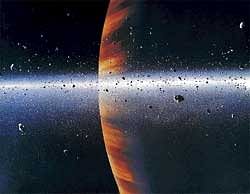Icy asteroid may explain how life began on earth

Using an Hawaii based NASA telescope, scientists found that asteroid 24 Themis, which sits halfway between Mars and Jupiter in an area called the Main Belt, contains both ice and widespread organic chemicals.
Through an analysis of infrared sunlight reflected by the 200-km wide asteroid, the researchers discovered that the spectrum was consistent with frozen water and determined the object is coated with a thin film of ice.
Joshua Emery, a planetary astronomer and an author of the study, said discovering ice on 24 Themis was a surprise because the surface is too warm for it to stick around for a long time.
The research, Emery said, implies that ice is quite abundant in the interior of 24 Themis and perhaps many other asteroids and it supports the possibility that the essential building blocks for life came from asteroids.
“This ice on asteroids may be the answer to the puzzle of where earth’s water came from,” he was quoted as saying by the “Telegraph”. “The organics we detected appear to be complex, long-chained molecules.
“Raining down on a barren earth in meteorites, these could have given a big kick-start to the development of life,” said Emery. Asteroids were once believed to be dry and lifeless but after the findings it is now believed they played a vital role in the evolution of life.
Though scientists are still not clear how the water got there as the asteroid’s proximity to the sun causes ice to vapourise, the findings suggest its lifetime of ice ranges from thousands to millions of years depending on the latitude.
So the ice is regularly being replenished possibly by a process of “outgassing” in which ice buried within the asteroid escapes slowly as vapour migrates through cracks to the surface or as vapour escapes quickly and sporadically when 24 Themis is hit by space debris.
Since Themis is part of an asteroid “family” that was formed from a large impact and the subsequent fragmentation of a larger body long ago, this scenario means the parent body also had ice and has deep implications for how our solar system formed.
“Extending this refined view to planetary systems around other stars, the building blocks of life — water and organics — may be more common near each star’s habitable zone.
The scientists’ discovery also further blurs the line between comets and asteroids, the report said.